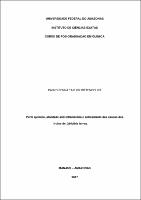| ???jsp.display-item.social.title??? |


|
Please use this identifier to cite or link to this item:
https://tede.ufam.edu.br/handle/tede/6092| ???metadata.dc.type???: | Dissertação |
| Title: | Perfil químico, atividade anti-inflamatória e antioxidante das cascas dos frutos de Libidibia ferrea |
| ???metadata.dc.creator???: | Bittencourt, Paulo Senna Taylor  |
| ???metadata.dc.contributor.advisor1???: | Nunomura, Rita de Cássia Saraiva |
| ???metadata.dc.description.resumo???: | Libidibia ferrea é uma árvore de médio porte conhecida como jucá, encontrada na região Norte e Nordeste do Brasil. O uso de diversas partes da árvore é muito comum na medicina popular, principalmente nas regiões longínquas dos grandes centros urbanos. Os frutos de jucá são utilizados na forma de chá ou decocto para prevenir ou tratar inflamações. Os frutos foram coletados na zona urbana da Cidade de Manaus/Amazonas. Após triturado, 300 g de pó de jucá foram extraídos por maceração em metanol por cinco dias obtendo-se o extrato bruto. As análises em CLAE-EM foram realizadas no extrato metanólico bruto das cascas do fruto de jucá e no extrato bruto hidrolisado, sendo identificados alguns taninos hidrolisáveis, ácido HHDP, ácido DHHDP e ácido clorogênico. O extrato bruto foi submetido a partição líquido-líquido, obtendo-se as fases em hexano, clorofórmio, acetato de etila e fase hidroalcoólica. Foram realizados testes de atividade antioxidante (DPPH e ABTS) e anti-inflamatório (LOX) nas fases obtidas. A fase em acetato de etila apresentou maior eficácia em todos os testes (IC50 DPPH = 3,32, IC50 ABTS= 4,12, IC50 LOX = 8,62), enquanto que a fase em hexano apresentou os piores resultados entre as frações (IC50 DPPH = 59,92, IC50 ABTS= 211,37, IC50 LOX = 140,45). A fase AcOEt foi submetida a cromatografia em coluna utilizando Sephadex LH-20 e metanol como fase móvel. A fração resultante AcS2 foi fracionada em Sephadex LH-20 novamente utilizando metanol como fase móvel, cuja fração AcSS2 foi submetida a extração em fase sólida utilizando como fase móvel misturas de H2O/ACN. Todas as frações foram analisadas em CLAE analítica e as frações 6 e 7 foram reunidas e foram identificados o ácido elágico e a metoxigeraniina, a elucidação das substâncias ocorreu por EM-APCI modo negativo e RMN (MeOD, 500 MHz). Por fim, ensaios de atividade antioxidante foram realizados para o ácido elágico (IC50 DPPH = 49,57, IC50 ABTS= 60,00) e para a metoxigeraniina (IC50 DPPH = 8,59, IC50 ABTS = 6,49). O método de isolamento presente neste trabalho pode ser utilizado para a obtenção de outras substâncias com atividade antioxidante e anti-inflamatória e também para a quantificação dessas substâncias. |
| Abstract: | Libidibia ferrea is a medium-sized tree known as jucá, found in the North and Northeast of Brazil. The use of various parts of the tree is very common in folk medicine, especially in the distant regions of large urban centers. Jucá fruits are used in the form of tea or decoction to prevent or treat inflammation. The fruits were collected in the urban area of the City of Manaus / Amazonas. After grinding, 300 g of jucá powder were extracted by maceration with methanol for five days to obtain the crude extract. The analyzes in HPLC-MS were performed on crude metanolic extract of juca fruit peels and crude hydrolyzed extract. Some hydrolysable tannins, HHDP acid, DHHDP acid and chlorogenic acid were identified. The crude extract was subjected to a liquid-liquid partition, to give the phases in hexane, chloroform, ethyl acetate and hydroalcoholic phase. Tests of antioxidant activity (DPPH and ABTS) and anti-inflammatory (LOX) were performed in the phases obtained. The ethyl acetate phase was more effective in all the tests (IC50 DPPH = 3.32, IC50 ABTS = 4.12, IC50 LOX = 8.62), while the hexane phase presented the worst results among the fractions (IC50 DPPH = 59.92, IC50 ABTS = 211.37, IC50 LOX = 140.45). The AcOEt phase was subjected to column chromatography using Sephadex LH-20 and methanol as the mobile phase. The resulting AcS2 fraction was fractionated in Sephadex LH-20 again using methanol as the mobile phase, whose AcSS2 fraction was subjected to solid phase extraction using as the mobile phase H2O/ACN mixtures. All fractions were analyzed in analytical HPLC and fractions 6 and 7 were pooled and ellagic acid and methoxygeraniine were identified, the elucidation of the substances occurred by negative-mode EM-NMR and NMR (MeOD, 500 MHz). Finally, antioxidant activity assays were performed for ellagic acid (IC50 DPPH = 49.57, IC50 ABTS = 60.00) and methoxygeraniine (IC50 DPPH = 8.59, IC50 ABTS = 6.49). The isolation method present in this work can be used to obtain other substances with antioxidant and anti-inflammatory activity and also for the quantification of these substances. |
| Keywords: | Libidibia ferrea Lipo-oxigenase Substâncias fenólicas Ácidos fenólicos |
| ???metadata.dc.subject.cnpq???: | CIÊNCIAS EXATAS E DA TERRA: QUÍMICA |
| Language: | por |
| ???metadata.dc.publisher.country???: | Brasil |
| Publisher: | Universidade Federal do Amazonas |
| ???metadata.dc.publisher.initials???: | UFAM |
| ???metadata.dc.publisher.department???: | Instituto de Ciências Exatas |
| ???metadata.dc.publisher.program???: | Programa de Pós-graduação em Química |
| Citation: | BITTENCOURT, Paulo Senna Taylor. Perfil químico, atividade anti-inflamatória e antioxidante das cascas dos frutos de Libidibia ferrea. 2017. 103 f. Dissertação (Mestrado em Química) - Universidade Federal do Amazonas, Manaus, 2017. |
| ???metadata.dc.rights???: | Acesso Aberto |
| ???metadata.dc.rights.uri???: | http://creativecommons.org/licenses/by-nc-nd/4.0/ |
| URI: | http://tede.ufam.edu.br/handle/tede/6092 |
| Issue Date: | 23-Feb-2017 |
| Appears in Collections: | Mestrado em Química |
Files in This Item:
| File | Description | Size | Format | |
|---|---|---|---|---|
| Dissertação_Paulo Senna.pdf | 2.49 MB | Adobe PDF |  Download/Open Preview |
This item is licensed under a Creative Commons License





